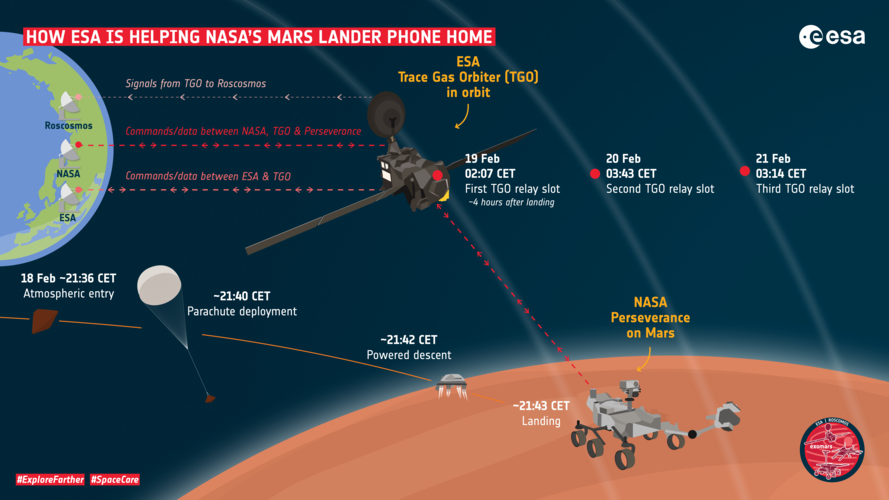NASA’s Mars 2020 Perseverance rover is due to land on the Red Planet at 21:43 CET on 18 February 2021. In order to communicate with Earth from its landing site in Jezero Crater, the rover will rely on spacecraft orbiting Mars to relay the images and other data it collects back to Earth and pass on the commands from engineers beamed across space in the other direction.
ESA’s ExoMars Trace Gas Orbiter (TGO) is one of these spacecraft. As its orbit takes it over the landing site, TGO will enter communication windows with Perseverance and relay data between Earth and the rover via a network of deep space ground stations on Earth, including ESA’s Estrack network.
The data transmitted by Perseverance in its first hours and days will be vital to the mission. Did the rover land safely? Are all of its systems functional?
To ensure that this information gets to the engineers on Earth as quickly as possible, TGO and NASA’s mars orbiters will be able to communicate with deep space ground stations on Earth almost twenty four hours a day, seven days a week for the first two weeks after landing. ESA’s ground station network will provide roughly 14 hours a day of this ‘low-latency’ coverage.
“TGO will provide low-latency data relay support to Perseverance during this period, and continue to provide routine relay support afterwards,” says ESA’s Peter Schmitz, TGO Spacecraft Operations Manager. “Our first relay session with TGO will start at 02:07 CET on 19 February, just four hours after landing.”
The Trace Gas Orbiter is the first of two missions of ESA’s ExoMars programme that is attempting to determine whether life has ever existed on Mars. TGO arrived at Mars in October 2016 and is conducting a detailed study of the atmosphere and mapping signatures of water below the planet’s surface. The orbiter is operated from ESA’s European Space Operations Centre in Darmstadt, Germany and mission controllers already have a lot of experience relaying data from existing Mars landers.
“The orbiter usually supports one relay session per lander per day, but from 18 February, we will be supporting an additional two sessions per day for Perseverance,” says Schmitz. “From then on, TGO will relay twice the volume of data to and from the surface of Mars as it does now.”
In total, Perseverance will communicate with NASA or ESA Mars orbiters at least twice a day, and typically four to six times. During these sessions, data and images will be sent to NASA to help the operations team plan the rover’s activities for the following days



 Image:
ESA's Trace Gas Orbiter will relay data from NASA's Perseverance rover to ground stations on Earth
Image:
ESA's Trace Gas Orbiter will relay data from NASA's Perseverance rover to ground stations on Earth